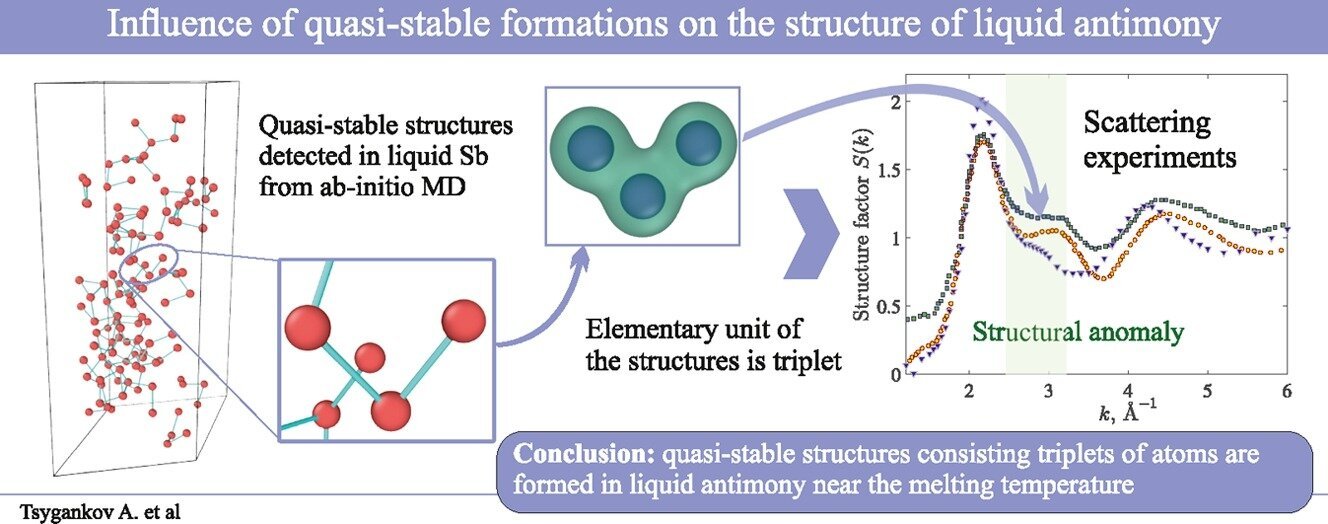Antimony, a chemical element that is widely utilized in the production of materials for electronics and corrosion-resistant metal alloys, has long been of interest to researchers for its unique properties. One of the fascinating aspects of molten antimony is its ability to form unusual atomic structures near the melting point, providing valuable insights into both its physical properties and potential applications in the development of advanced materials.
Recent studies led by Dr. Anatolii Mokshin, Chair of the Department of Computational Physics and Modeling of Physical Processes, have uncovered remarkable findings regarding the behavior of molten antimony. These findings challenge traditional understandings of atomic interactions and could significantly influence the design of future materials. According to Dr. Mokshin, “Antimony melt is interesting because near the melting point, the atoms in this melt can form bound structures in the form of compact clusters or extended chains and remain in a bound state for quite a long time.”
Unveiling the Atomic Behavior in Molten Antimony
The study revealed that the fundamental building blocks of these complex structures are linked triplets of adjacent atoms, forming what Dr. Mokshin describes as “right triangles” at their vertices. These triplets serve as the foundation for larger atomic clusters or chains, which contribute to the anomalous structural features observed in experiments involving neutron and X-ray diffraction.
Using quantum-chemical calculations, the team employed computer modeling methods to reproduce these anomalies with high accuracy. This approach provided a detailed simulation of the atomic interactions in molten antimony, confirming the presence of these long-lived structures and providing a more precise explanation for their existence. “We found that the basic unit of these structures are linked triplets of adjacent atoms, and the centers of mass of these linked atoms are located at the vertices of right triangles,” explained Dr. Mokshin.
One of the most intriguing aspects of the study is the fact that these unusual atomic formations persist for an extended period of time in molten antimony, despite the typically chaotic behavior expected from liquids at high temperatures. This ability of atoms to form stable clusters or chains under specific conditions near the melting point is a phenomenon that warrants further exploration.
The Role of Structural Anomalies in Material Science
The structural anomalies observed in molten antimony have significant implications for understanding the behavior of materials at the atomic level, especially as they relate to the design of novel materials with tailored physical and chemical properties. According to Bulat Galimzyanov, an Associate Professor at the Department of Computational Physics and Modeling of Physical Processes, these anomalies are seen as “additional bursts in experimental neutron and X-ray diffraction patterns.” Such bursts are typically considered unusual signals, and their detection has led to ongoing debates regarding the physical nature of these features.
This study contributes to a better understanding of the atomic interactions within materials as they melt, providing critical insights into the processes that govern the behavior of matter at the molecular level. The ability to precisely model these anomalies using quantum-chemical techniques is a step forward in addressing the questions that have puzzled researchers for years.
While the phenomena observed in molten antimony are striking, they are not unique. Similar structural anomalies have been observed in the melt of pure bismuth, a substance that, like antimony, belongs to the chemical group of pnictogens. The discovery that long-lived atomic structures can form in both antimony and bismuth suggests that there may be a unified explanation for these phenomena across different materials. “We have discovered that near the melting point, long-lived structures can also form in bismuth,” said Artem Tsygankov, an Assistant Lecturer at the department. “This suggests that the physical processes in these melts can be described in a unified way.”
This shared behavior in both antimony and bismuth hints at a deeper, fundamental principle governing the behavior of melts in certain elemental groups, offering new pathways for understanding the nature of materials under extreme conditions.
Implications for Material Design and Practical Applications
The findings of this study have profound implications for material science and engineering, particularly in the development of new materials with unique properties. The ability to predict and control the formation of atomic structures in molten states could lead to the creation of materials with specific mechanical, thermal, and electrical properties. This could benefit industries ranging from electronics to aerospace, where high-performance materials are essential for innovation.
Moreover, the study highlights the importance of understanding atomic and molecular interactions on extremely small scales, which can influence the macroscopic properties of materials. These insights are crucial not only for fundamental science but also for the design of advanced alloys, semiconductors, and materials resistant to high temperatures and corrosion.
As researchers continue to investigate the complex behaviors of molten antimony and other pnictogens, these findings pave the way for further exploration into the atomic-level processes that underlie the formation of functional materials. The application of quantum-chemical modeling in this context provides an essential tool for researchers seeking to design next-generation materials with properties that can be tailored to meet specific industrial needs.
Conclusion
The study of molten antimony and its structural anomalies opens a new chapter in our understanding of the behavior of materials at high temperatures. By revealing the formation of linked atomic triplets and extended clusters, researchers have provided valuable insights into the physical processes occurring in molten states. These discoveries not only deepen our fundamental understanding of material science but also offer practical applications in the design of advanced materials with enhanced properties.
As scientists continue to explore the behavior of antimony and bismuth, they are uncovering critical patterns that could be applied to a wide range of industrial and technological innovations. The findings contribute to the broader effort to control and manipulate materials at the atomic level, leading to more efficient, durable, and versatile materials for use in electronics, aerospace, and beyond.
Reference: Artem A. Tsygankov et al, Physical nature of quasi-stable structures existing in antimony melt, Journal of Molecular Liquids (2024). DOI: 10.1016/j.molliq.2024.126699
